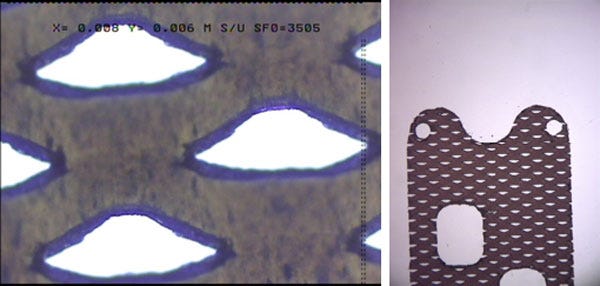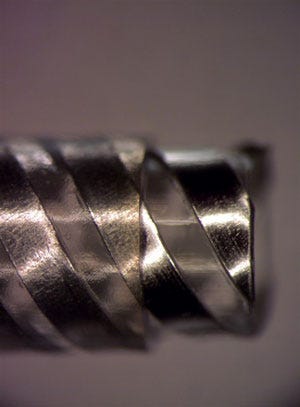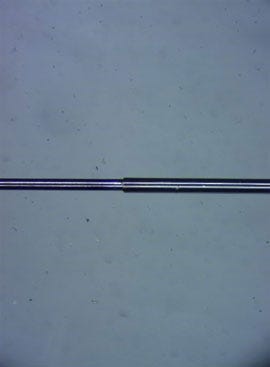February 5, 2016
New laser micromachining technology enables the machining of hybrid metal-polymer medical device components.
Doug Pulfer
Many life science devices are constructed as a combination of metals and polymers. Metals offer the benefits of radial strength, memory shape, structural reinforcement, and electrical conductivity. Polymers offer the benefits of biocompatibility, flexibility, electrical insulation and lower cost. It is general practice to use one set of microfabrication methods for metals and a different set for polymers, especially as features sizes get smaller, down to few microns or thousandths of inches. The development of novel laser micromachining methods, however, makes it possible to simultaneously machine alternating layers of polymers and metals for delivery devices such as braided shafts. Lasers are also able to selectively discriminate between the two material types, etching one material without affecting the other, such as stripping polymer coatings from wires or electrical contact pads.
Imagine the technical challenge here: polymers are soft materials that melt easily; metals are hard materials that require high temperatures to melt. If a laser is tuned to machine a polymer, then the laser beam is not intense enough to etch into the metal. If a laser is tuned to machine metals, then the laser intensity will most certainly melt and char the polymer.
The advent of ultrafast laser technology helps bridge the gap between polymers and metals. These lasers operate at pulse lengths of 10-12 to 10-15 seconds, typically three to six orders of magnitude shorter than conventional lasers, permitting the ablation of metals with reduced slag or heat-affected zone. In addition, operating the ultrafast lasers at the green or ultra-violet wavelengths (two to three times shorter in wavelength) achieves better light absorption in polymer materials, allowing fine features to be machined without burning or charring.
Laser Ablation of the Inner Liner of a Braided Shaft
A braided shaft is a delivery catheter for medical devices. It is composed of an outer polymer layer, typically pebax or polyimide, with an underlying crisscross pattern of stainless steel braids to give the shaft structural reinforcement. The shaft has an inner PTFE liner so that a deployable device can pass smoothly along the shaft, taking advantage of the natural lubricity of the inner liner.
With a polymer-metal-polymer construction, the shaft's distinctive material properties require the laser to couple with one material, yet be transmitted by the other material. Otherwise, it would be necessary to significantly increase the laser energy, with collateral damage to the other material.
In a recent example, however, the fluoropolymer inner liner was removed by a laser that also readily etched the outer polymer (and likely the stainless steel braid, as well). Therefore, directing laser light from the outside in, to couple with the thin fluoropolymer only, was not going to work. The solution was to develop novel beam-steering methods to laser-etch a small section of the fluoropolymer inner liner with no change to the stainless steel braid or the outer polymer coating (see Fig.1)

Figure 1: Laser Ablation of Inner PTFE Liner (length 1.5mm) from Polyimide-coated Shaft
Outer Pebax Removal from Coiled Shaft without Affecting Inner Polyimide Liner
|
Figure 2: Removal of Pebax Outer Coating to "Clean" the Stainless Coil, With No Damage to the Inner Polyimide Liner (Length 2mm) |
Another example of a catheter design that presented a machining challenge was one with these three layers: an outer Pebax coating, a mid-layer reinforced by flat coiled stainless steel, and an inner lining of thin Polyimide. In this example, the outer Pebax coating needed to be removed. Adding to the challenge, the braid was coiled in an open pattern and the opening size at the ends varied from part-to-part and place-to- place. To compensate for the random pattern, a set of computer-controlled lasing steps with machine vision were developed to make a robust and repeatable process.
Dimensional Tolerance Challenges in a Stretchable Material
The size of the wires used in life science devices is shrinking along with the size of the devices themselves. Imagine the challenge of laser-stripping the thin polymer coating from an ultra-thin Ag-core wire (48 AWG, diameter is approx. 30 microns) in a reel-to-reel fashion. These delicate wires require specialized handling: it's important that they do not stretch, kink or break in a reel-to-reel transport system.
A typical case involving these thinner wires presented some challenging criteria:
The metal alloy core needed to be shiny, with no evidence of a heat-affected zone,
The transition zone from exposed wire to coating needed to be sharp, with no angling or visible stitching from the top-stripped area to the bottom-stripped area,
The parts varied in strip lengths as well as length between strip zones with a +/-0.001-in. tolerance
To address these challenges, laser micromachining workstations were engineered with handling mechanisms to exert no more than a few grams of tension at any point in the reel-to-reel transfer and handling mechanisms. Using both short pulse and/or short wavelength, they laser stripped the wire and met the requirements for a sharp transition zone and no heat-affected zone on the metal alloy core.
|
Figure 3: Automated Laser Wire Stripping of Fine Gauge Wire |
One other recent application involved high-speed laser cutting out of parts from PTFE mesh. The issue here was not the lasing operation itself: high-speed laser cutting of flat fluoropolymer parts is not a big challenge. Dimensional inspection of the parts, however, was found to be very difficult because the open-weave mesh moves and stretches with handling and distorts even when simply moved a couple of inches on a stainless steel lab table. For the required dimensional inspection, a "Go-No Go" fixture was developed so that parts could be fitted onto the fixture; if they fit, the dimensions were deemed in specification.
The life science industry faces many unique challenges in meeting the ever increasing, tighter machining tolerances in polymer-metal or polymer-metal-polymer constructions. Polymers and metals have very different melt temperature regimes that make it difficult to machine hybrid devices. Not only does handling smaller devices become a challenge, the reduced amount of remaining material after machining affects the part mechanical stability, which in turn affects the ability to inspect the parts. To address these microfabrication issues, laser micromachining technology, including the use of ultrafast lasers, has become a valuable tool for both device designers and manufacturers.

Figure 4: PTFE Mesh
Doug Pulfer is a technical sales engineer at Resonetics (Nashua, NH).
About the Author(s)
You May Also Like




